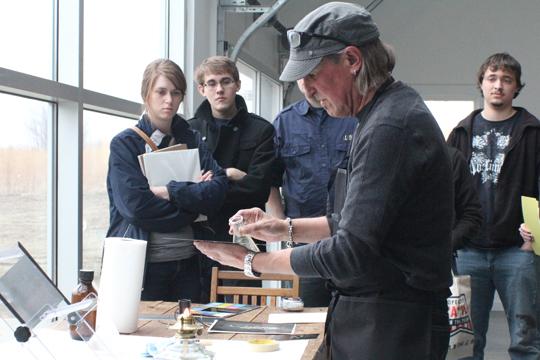Retro camera class explores classic photography process
March 26, 2011
Traveling along some of the old highways of Northeast Kansas can reveal a great many historical landmarks. Among them is a modern art studio housing a virtual temple to an archaic art form.
Washburn art students recently had the chance to travel to such a place as part of a class that is a fusion of passion, art and knowledge for the students as well as the teacher.
MaryDorsey Wanless, assistant professor in the art department always embraced her student’s desires in terms of what kind of classes she will take on.
The creation of a class that focuses on student interests gave birth to the retro camera class which has been exploring the roots of photography through the use of antique cameras that students have been acquiring over time. Something that their teacher has some knowledge about.
“I have around 30 old cameras,” said Wanless. “I’ll go to an antique shop and see one and struggle with not getting it.”
The students in the class have similar passions for their unique equipment as they have spent a great deal of time investing themselves into the process of taking pictures and developing them.
“It’s been an adventure getting the old film and equipment ready for the class,” said Wanless. “We had someone come in and help us with getting our cameras ready to shoot.”
As part of the process of learning more about old techniques, the class traveled to rural Kansas, west of Lecompton, to visit one of the few people in the country using a process called collodion process.
Thomas Gibson is a photographer whose past has taken him from the highs of Milan, Italy and high fashion to the glamorous world of Los Angeles, Calif. and Capitol Records album cover photo shoots. His transition through his professional life brought him to the Midwest and his love of a dying art form is what kept him.
“It’s just serendipity really,” said Gibson during question and answer with students after his presentation on collodion processes.
With plaques celebrating some of his work with notable musical artists like Rick Springfield and Bono of U2 adorning the walls of his studio, Gibson still manages to keep a humble stance to what he does.
“It’s one of the coolest things I’ve done,” said Gibson. “I mean it’s a real unique art form. Everything you make is really one of a kind with this process.”
The impressiveness of the studio and the unique nature of the process aren’t lost on the students either.
“It’s a difficult process that requires a lot of discipline and work,” said Crystal Katzer, senior art major. “It’s a great opportunity for us to come here and see someone who can do this process and offer us resources.”
Beyond the hands on learning that the students get from shooting with their old cameras and interacting with fellow artists like Gibson, the class also has an academic research portion.
“We are doing some scholarly research as well,” said Wanless. “The class will be presenting at Aperion so it’ll be great to get some scholarly recognition for our students.”
For more information on the collodian process and to learn more about Thomas Gibson, go to www.thomasgibsonstudio.com or call (785) 887-6009.



